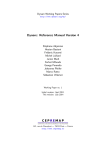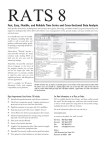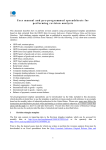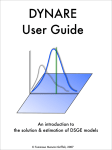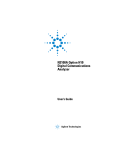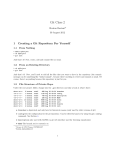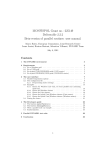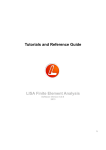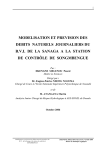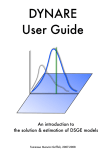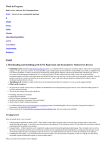Download II test user manual
Transcript
Testing Macro Models Using Indirect Inference David Meenagh 1. Yongdeng Xu 1 Introduction Indirect Inference provides a classical statistical inferential framework for testing a model. The aim is to compare the performance of the auxiliary model estimated on the simulated data derived from the model, with the performance of the auxiliary model when estimated from the actual data. In practice we use a VAR as the auxiliary model, but you could also use IRFs and moments. If the structural model is correct then its predictions about the time series properties of the data should match those based on actual data. We choose a VAR as the auxiliary model because the solution to a loglinearised DSGE model can be represented as a restricted VARMA model, and this can be closely represented by a VAR. A level VAR can be used if the shocks are stationary. In what follows we do not assume that the data is stationary; however if you wish only to use stationary data then you may ignore the remarks below about trends and tests of non stationarity of the error processes. 2. Model Evaluation by Indirect Inference The method of evaluating a model by Indirect Inference is carefully explained for users in Le et al. (2015) which should be cited when using any of these programmes. The method was introduced and refined in a series of papers referred to there. The criterion we use when evaluating the model is the Wald test of the differences between the vector of relevant VAR coefficients from simulated and actual data. If the DSGE model is correct then it should produce simulated data that is similar to the actual data, and therefore the VAR estimates on the simulated data will not be significantly different from the VAR estimates on the actual data. From the actual data we get the VAR parameters βa , and from the simulations we get N sets of VAR parameters β (for i = 1::N), from which we perform the relevant calculations. The Wald statistic that we calculate is: i W = ( β a − β )'Ω −1 ( β a − β ) (1) 1 N i 1 N i i Ω = cov( β − β ) = ( β − β )( β i − β ) ' . β and where β = E( β ) = ∑ ∑ N i=1 N i=1 i In essence we are measuring the distance the actual VAR parameters are from the average of the simulated VAR parameters. 2.1 Implementation of the Wald test by bootstrapping Suppose the DSGE model is A0 Et yt +1 = A1 yt + zt (2) zt = D3 zt−1 + E2ε t 1 [email protected]; Cardiff Business School, Cardiff University, Aberconway Building, Colum Drive, Cardiff, CF10 3EU, UK The DSGE model is solved by Dynare (Juillard, 2001). The solved reduced form is xt = Axt −1 + Bε t where xt = ( yt , zt , at ) ' , at are the auxiliary variables. The coefficients (3) A and B are derived from (2) 2. The following steps summarise how to implement the Wald test by bootstrapping: Step 1: Calculate the residuals and innovations of the economic model conditional on the data and parameters. Step 2: Derive the simulated data by bootstrapping Step 3: Compute the Wald statistic. Step 1: Calculating the model residuals ( zt ) and innovations ( ε t ). The number of independent structural residuals is taken to be less than or equal to the number of endogenous variables. Using the data and the parameters we can calculate the structural errors. If the equation does not have any expectations then the residuals are simply backed out from the equation and the data. If the equation has expectations in it we need to estimate the expected values. To do this we use the robust instrumental variables methods of McCallum (1976) and Wickens (1982), with the lagged endogenous data as instruments. In practice we estimate a VAR of all the expected variables and use this to calculate the expectations. In some DSGE models many of the structural residuals are assumed to be generated by autoregressive processes. If they are, then we need to estimate them. After re-estimation of AR coefficients, we can calculate model innovations. We call this method ‘LIML’. This procedure is implemented by the Get_Res_LIML() function. [residual,inno,rho_est] = GetRes_Exact(fname,act_data,[]); Or if we obtained the AR coefficients from calibration or estimation (as e.g. in SW(2007) model), we can get the model innovations directly from the solved reduced form. We call this method the ‘exact method’. This procedure is implemented by Get_Res_Exact() function. [residual,inno,rho_est] = GetRes_LIML(fname,act_data,inx_expect,inx_eqs); The details of two methods are explained in the next section. Step 2: Simulating the data. Once we have the model innovations, we can simulate the data by bootstrapping these innovations. We bootstrap by time vector to preserve any simultaneity between them, and solve the resulting model using Dynare. More specifically, the bootstrapped data xt is obtained from equation (3). To obtain the N bootstrapped simulations that we need we repeat this process, drawing each sample independently. This procedure is implemented the Boots_data() function. Another type of bootstrap is the parametric bootstrap. That is to say if we know the error distribution (i.e. variance), we can also bootstrap the data from Monte Carlo simulation. There is an option type that you can choose to use parametric or residual bootstrap. type=2; 2 %type=1, boostrap from unknown shocks %type=2, boostrap from known shocks (MC simulation) In dynare, A=oo_.dr.ghx; B=oo_.dr.ghu; boots_data = Boots_data(fname,act_data,inno,nboot,A,B,stv,type); Step 3: Compute the Wald statistic. We estimate the auxiliary model — a VAR(1) — using both the actual data and the N samples of simulated data. We then calculate the Wald statistic using equation (1). The bootstrap distribution of the Wald statistic can be found by substituting each Equation (1). β i for β a in The choice of variables and the order of the VAR is up to you. The Wald test is a strict test, so increasing the order of the VAR makes the test more stringent; hence in practice we use a VAR(1). You can use all the variables in the VAR, or a subset of variables to see what combinations of parameters the model can fit. For the model to fit the data at the 95% confidence level we want the Wald statistic for the actual data to be less than the 95th percentile of the Wald statistics from the simulated data. The Wald statistics from the simulated data come from a the number of parameters in β χ2 distribution with degrees of freedom equal to k-1, where k is . To make it easier to understand whether the model has not been rejected by the data we transform the Wald for the actual data into a t-statistic using the formula and scale it so that if the Wald was equal to the 95th percentile from the simulated data we would get a Transformed Wald of 1.645. ⎛ 2 wa − 2k − 1 ⎞ T = 1.648 ⎜ ⎟ ⎜ 2 w0.95 − 2k − 1 ⎟ ⎝ ⎠ where wa is the Wald statistic on the actual data and of the simulated data. (4) w0.95 is the Wald statistic for the 95th percentile This procedure is implemented by Wald_stationary()function. [pvalue, Wald, Trans_Wald] = Wald_stationary(act_data(var_no,:),boots_data(var_no,:,:),var_order,var_var iance); Remark: IIW test when shocks are non-stationary After we get model residuals zt , we would like to know if the shocks are stationary. The ADF test is used. Empirical work on the SW model finds that most of the variables are stationary, except the productivity shock (Meenagh et al. (2012)). For nonstatioanry shocks, we consider the following autoregressive process Δzt = ρΔzt −1 + ε t And we re-estimate this error process and get the model innovation (5) ε t for 3 productivity shocks. For other stationary shocks, we use an AR(1) process in levels, and get the model innovation as usual. 3 If you find any other non-stationary shocks when you implement the test, you can use same error process. But you had better not rely only on ADF test. Make your own judgement and do not use too many nonstationary shocks. A suggestion is that you only consider nonstationarity for productivity. There is often ambivalence in the tests for stationarity of the shocks and in this case the deciding factor can be the Wald test for the overall model including the assumed status of the shocks. After that, we modify the error process in “fname.mod” file and update the AR coefficients. And then we run “dynare fname.mod” again to get “A” and “B” matrix and bootstrapped the data from equation (3). You could add any trend terms found in the errors to the simulated data manually. But in the Wald test, we are normally only interested in the dynamic properties of the data and not in the trend terms. So it is not necessary to add trend terms to the simulated data. The bootstrapped data from equation (3) maintains the dynamic properties of the model. Trend terms can be included in the VAR estimated on the data; then the trend coefficients are ignored in the Wald. The choice of auxiliary equation follows Davidson et.al.(2010) and Meenagh et.al.(2012). To use these methods on non-stationary data we need to reduce them to stationarity. This we do by assuming that the variables are cointegrated with a set of exogenous non-stationary variables, so that the residuals are stationary. We then difference the data and write the relationships as a Vector Error Correction Mechanism, as we now explain. We suppose that in the class of structural models in which we are interested as potential candidates for the true model the endogenous variable vector yt can be written in linearised form as a function of lagged y, a vector of exogenous variables xt , zt , and of errors εt . yt = f ( yt −1 , xt , zt , ε t ) xt are Now we assume that zt (6) non-stationary, I(1), variables with drift trends (which may be zero); that are I(0) with deterministic trends (that may be zero) and that εt are exogenous variables defined as before. Thus there are cointegrating relationships in the model that define the ‘trend’ values of y as linear functions of the ‘trends’ in these exogenous variables or Δxt = ρΔxt −1 + d + ε1t then xt = xt + ρ 1− ρ Ayt = Bxt + Czt where for example if Δxt + dt ; we note also that zt = c + et + b( L)ε 2t . Hence yt = A−1 ( Bxt + Czt + ft ) . We now define the VECM as: Δyt = Cε1t + Dε 2t + Evt − Γ( yt −1 − yt −1 ) We can rewrite this as a VAR in the levels of (7) yt , augmented by the arguments of yt : yt = ( I − Γ) yt −1 + Γyt −1 + ηt = ( I − Γ) yt −1 + ΓA−1 [ Bxt −1 + C (c + et ) + ft ]+ ηt (8) = Fyt −1 + Gxt −1 + ht + ηt + cons where ηt = A−1[Cε1t + Dε 2t + Evt ] .It should be noted that ‘cons’ includes dummy constants for outliers in the errors – we interpret these as effects of one-off events such as strikes. This is our auxiliary equation in the indirect inference testing procedure. We estimate it both on the data and on the data simulated from the model bootstraps. It allows us to test whether the model can capture the 4 relationships in the data; we focus on the matrices F in practice. This IIW test procedure is implemented by the following function: 4 A necessary condition for the stationarity of the VECM arguments is that elements of yt both yt is cointegrated with the in the data and in the bootstrap simulations; we check for this and report if it is not satisfied, as this would invalidate the tests. [pvalue, Wald, Trans_Wald ] = Wald_nonstationary(act_data(var_no,:),boots_data(var_no,:,:),act_nonstatRes id,boots_nonstatResid,rho_nonstat,var_order,var_variance); 3. Details of how to get model residuals and innovations To get model errors 3.1 εˆt , there are two ways, the exact and the LIML method. Exact method – when shock AR coefficients are known In the exact method, we know the structure of shock process. Suppose we know it follows an AR(X) process and know the AR coefficients. We can obtain the model errors from the observed data and model parameters exactly, For example, suppose the DSGE model is A0 Et yt +1 = A1 yt + zt (9) zt = D3 zt −1 + E2ε t The reduced form is xt = Axt −1 + Bε t where xt = ( yt , zt , at ) ' , at are the auxiliary variables. The coefficient matrices (10) A and B are derived from (9) 5 Re-writing it in declaration order : xt = Dxt −1 + Eε t (11) Or ⎛ yt ⎞ ⎛ D1 ⎜ ⎟=⎜ ⎝ zt ⎠ ⎝ 0 D2 ⎞⎛ yt −1 ⎞ ⎛ E1 ⎞ ⎟⎜ ⎟ + ⎜ ⎟ε D3 ⎠⎝ zt −1 ⎠ ⎝ E2 ⎠ t (12) We find that ( yt − D1 yt −1 ) = D2 zt −1 + E1ε t = E1 E2−1 ( E2 E1−1D2 zt −1 + E2ε t ) −1 2 t = E1E z since 5 E2 E1−1 D2 = D3 . So where E=B(oo_.dr.inv_order_var,:); D=[zeros(M_.endo_nbr,M_.nstatic) A(:,1:M_.nspred)zeros(M_.endo_nbr,M_.nfwrd)]; D=D(oo_.dr.inv_order_var,oo_.dr.inv_order_var); (13) zt = ( E1 E2−1 ) −1 ( yt − D1 yt −1 ) (14) If the number of independent structural residuals is equal to the number of endogenous variables, E1 is a squared matrix, so the residuals are obtained through the above equation. If the number of independent structural residuals is less than the number of endogenous variables, we make use of part of the endogenous variables and part of E1 , which makes E1 a squared matrix, and obtain the residuals through the above equation. Then, the model innovations are ε = E2−1 ( zt − D3 zt −1 ) (15) t We can also estimate rhos through the exact method. The exact method is conducted through iteration. We start with a set of rhos, most easily derived from LIML. Get a new set of residuals and rhos from the equations below; repeat until convergence ˆ + εˆ zt = Rz t −1 t (16) This procedure is implemented by Get_Res_Exact() function. [residual,inno,rho_est] = GetRes_Exact(fname,act_data,[]); 3.2 LIML – unknown shocks Under the LIML method, we only need to know the structural parameters A0 and A1 . We do not require to know the shock process and error distribution. We then get the model residuals from LIML. Suppose the model is where VAR, yt +1 are ε t +1 A0 Et yt +1 = A1 yt + zt (17) zt = ? zt −1 + ? ε t (18) endogenous variables and zt are model residuals which may be represented by the are shock innovations, and are exogenous variables. Then we get model shocks from zt = A0 Et yt +1 − A1 yt where (19) Et yt +1 is estimated from LIML. If the equation has expectations in it we need to estimate the expected values. To do this we use the robust instrumental variables methods of McCallum (1976) and Wickens (1982), with the lagged endogenous data as instruments. In practice we estimate a VAR of all the expected variables and use this to calculate the expectations. In implement the method, we make use dynare function “fname_dynamic.m” . When we run “dynare fname.mod”, Dynare also produces a “fname_dynamic.m” file. This is a function that generates “lhsrhs” of equation (17) and (18). To get model residuals zt , we input A0 , A1 , Et yt +1 , yt and let zt to be zero. Then the “lhs-rhs” in equation (17) are the model residuals. After we get the model residuals zt , we may need to determine the stationarity of the residuals and the structure of the shock process. The default process is AR(1). We then re-estimate the AR(1) process, get AR coefficients and model innovation εt . Note that you may want specify your own error process (e.g. ARMA), re-estimate it and get the model innovation εt . To do so, you need to amend this function manually. This procedure is implemented by GetRes_LIML() function. [residual,inno,rho_est] = GetRes_LIML(fname,act_data,inx_expect,inx_eqs); Please note that LIML estimates of AR coefficients are sometimes very biased. A better way is to start from LIML estimates of the AR coefficients, get a new set of AR coefficients from exact method; repeat until convergence. After re-estimation, you need to update the error process in dynare and run “dynare fname.mod” to get A and B matrices. 4. Examples Two examples, Smets-Wonters (2007) NK model and NK 3-equation model (used by Le et al,2011; Liu and Minford, 2014). Smets-Wonters model: sw_st.mod NK 3-equation NK model: NK3eq_st.mod Step1: Calculate the model residuals and innovations. dynare sw_st.mod; LIML method [residual,inno,rho_est,nst_inx] = GetRes_LIML(fname,act_data,inx_expect,inx_eqs) Input: • • • • fname: fname= M_.fname;. act_data: k*T matrix ind_lead=[1:7,13:14]; % The variables you used to generate E_t[y_(t+1)] by LIML ind_eq=[5 2 1 3 10 13 14]; % Select Equations that contains model residuals, • • • • Residual: is the structure residuals; k*T matrix Innovation: model innovations, exogenous variables ; k*T matrix rho_hat: estimated AR coefficients for structure residuals; nst_inx: index of nonstationary shocks if there are. Output: Exact method [residual,inno,rho_est] = GetRes_Exact(fname,act_data,[]); Step 2: Derive the simulated data by bootstrapping boots_data = Boots_data(fname,act_data,inno,nboot,A,B,stv,type); Input: • • • • • nboot: number of bootstraps. A: oo_.dr.ghx B: oo_.dr.ghx inno: model innovation type: Type=1: residual bootstrap; type =2 parametric simulation • boots_data: simulated data k*T*nboot matrix Output: Step 3: Compute the Wald statistic. [ pvalue, Wald, Trans_Wald] = Wald(act_data(var_no,:),Boots_data(var_no,:,:),var_order,var_variance); Input: • • • var_no=[1 2 3]; var_order=1; var_variance=1; • • Wald: Wald statistics Trans_Wald: Transformed Wald % Choice of variables in the Wald calculation % Order of Var in the Wald caculation % var_variance=1 ;including the volatility of shocks Output: Step3: Nonstatioanry case [Wald, Trans_Mdis_norm ] = Wald_nonstationary(act_data(var_no,:),boots_data(var_no,:,:),act_nonstatRes id,boots_nonstatResid,rho_nonstat,var_order,var_variance); Input: • • • var_no=[1 2 3]; var_order=1; var_variance=1; % Choice of variables in the Wald calculation % Order of Var in the Wald caculation % var_variance=1 ;including the volatility of shocks • act_nonstatResid: % • boots_nonstatResid xt for actual data; % xt for bootstrap data; • rho_nonstat % rhos • • Wald: Wald statistics Trans_Mdis_norm: Transformed Wald Output: 5. The power of the II Wald test The power of the IIW test is studied by Le et.al (2015). We examine the power of the Wald test by positing a variety of false models, increasing in their order of falseness. We generate the falseness by introducing a rising degree of numerical mis-specification for the model parameters. Thus we construct a False DSGE model whose parameters were moved x% away from their true values in both directions in an alternating manner (even-numbered parameters positive, odd ones negative); similarly, we alter the higher moments of the error processes (standard deviation) by the same +/ − x%. We may think of this False Model as having been proposed as potentially ‘true’ following previous calibration or estimation of the original model. The transformed Wald is calculated each time. The power of the test is the probability of rejecting a false model by the data (or the probability that Transformed Wald is bigger than 1.645). s=1:1000 [pvalue(s), Wald(s), Trans_Wald(s)] = Wald_stationary(act_data(var_no,:),boots_data(var_no,:,:),var_order,var_var iance); power=mean(Trans_Wald>1.645); 6. Model Estimation by II As mentioned earlier, the Wald statistic measures the distance between the data and the model. Therefore to estimate the model parameters we can use any minimising algorithm to minimise the Wald for the actual data. The function to minimise takes the coefficients as an input and then does Steps 1–3above, giving the Wald as the output. [ Trans_Wald ] = CalcWald(act_data,fname, coef ) The function CalcWald includes the three functions that calculate Wald statistics as stated in section 2(GetRes_Exact(),Boots_data(),Wald_stationary()). The input is actual data and starting coefficients and output is the transformed Wald. The fminsearchbnd algorithm supplied in Matlab is suggested, as it has been found to find global minima. In practice it is better to minimise the Transformed Wald because it is easier to see if we have found a set of parameters where the model is not rejected, as we are just looking to see if we found a Transformed Wald less than 1.645. II_coef=fminsearchbnd(@(II_coef) CalcWald(act_data,fname, II_coef),coef,lb,ub,options); References [1] Davidson, J, Meenagh, D, Minford, P & Wickens, M. 2010. Why crises happen- nonstationary macroeconomics. Working Paper E2010/13, Cardiff Economics Working Papers, Cardiff University [2]Juillard, M. (2001). Dynare: a program for the simulation of rational expectations models. Computing in economics and finance 213. Society for Computational Economics. [3]Le, V.P.M., Meenagh, D., Minford, P., Wickens, M., 2011. How much nominal rigidity is there in the US economy — testing a New Keynesian model using indirect inference. Journal of Economic Dynamics and Control 35(12), 2078–2104. [4] Le, V.P.M., Meenagh, D., Minford, P., Wickens, M., Xu, Yongdeng, 2015. Testing macro models by indirect inference: a survey for users. Forthcoming, Open Economic Review. [5] Liu, C. and Minford, P., 2014, How important is the credit channel? An empirical study of the US banking crisis, Journal of Banking and Finance, Volume 41, April, Pages 119-134. [6]McCallum, B. T. (1976) ‘Rational expectations and the natural rate hypothesis: some consistent estimates", Econometrica, 44, 43–52. [7] Meenagh, D., Minford, P. and Wickens M.R., 2012. Testing macroeconomic models by indirect inference on unfiltered data, Cardiff Working Paper No E2012/17, Cardiff University, Cardiff Business School, Economics Section; also CEPR discussion paper no 9058, CEPR, London. [8] Smets, F., Wouters, R., 2007. Shocks and Frictions in US Business Cycles: A Bayesian DSGE Approach. American Economic Review 97, 586--606. [9]Wickens, M.R. (1982) ‘The effcient estimation of econometric models with rational expectations", Review of Economic Studies, 49, 55–67.










